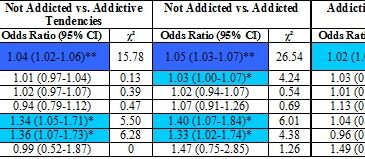The American public increasingly is becoming aware of the health risks of indoor tanning. Just this month, a 10% excise tax on indoor tanning went into effect; this tax is designed both to offset some of the costs of the nation’s health-care reform and to discourage the use of tanning beds. Given the health risks and increasing costs, why do people continue to engage in indoor tanning? For some, indoor tanning might represent an addiction, similar to the process of becoming addicted to substances. This week the STASH reviews an article that explores possible links among indoor tanning addiction, substance use, and mood disorders (Mosher & Danoff-Burg, 2010), implicating excessive indoor tanning as another manifestation of the addiction syndrome (Shaffer et al., 2004).
Methods
- Participants (n = 421) were recruited from students enrolled in psychology classes at a state university in the northeastern US.
- Participants completed a self-report questionnaire assessing several variables.
- Participants reported history of indoor tanning (i.e., ever tanned indoors and frequency of indoor tanning in the past year).
- To assess participants’ lifetime dependence on indoor tanning, researchers constructed indoor-tanning-related screens based upon the CAGE alcohol screen and the DSM-IV-TR substance-related disorder diagnostic criteria. The investigators classified participants into one of three mutually-exclusive categories: not addicted to indoor tanning, displaying addictive tendencies to indoor tanning (i.e. not addicted to indoor tanning but meeting addiction criteria for at least one of the CAGE or DSM screens), or addicted to indoor tanning (i.e. meeting criteria for both screens).
- Participants described their past-month substance use by reporting the number of days they had used each of 12 different substances during the past month.
- Researchers assessed past-week symptoms of anxiety and depression using standard inventories.
Results
- Among the 229 participants who reported ever tanning indoors, the mean number of past year indoor tanning visits was 23 (SD=24), 70 (30.6%) met the CAGE-based criteria for tanning addiction, 90 (39.3%) met the DSM-IV-TR-based criteria for tanning addiction, and 50 (21.8%) met the criteria for both.
- Table 1 shows the odds of the study measures predicting indoor tanning status.
- Compared with participants who were classified as not addicted (n = 119) to indoor tanning, participants who were classified as being addicted to indoor tanning (n = 50) reported (a) more frequent past-year indoor tanning use; (b) more symptoms of anxiety; (c) more days of alcohol use during the past-month; and (d) more days of marijuana use during the past-month.
- Compared with participants who were classified as not addicted to indoor tanning, participants who were classified as having addictive tendencies (n = 60) reported (a) greater past-month alcohol use, and (b) greater past-month marijuana use.
- Depression rates were not significantly different across all groups.

Figure. Odds Ratios (95% Confidence Interval) of Indoor Tanning Addiction Status for Study Measures (adapted from Mosher & Danoff-Burg, 2010). *p<0.05 **p<0.001 CI=Confidence interval. Click image to enlarge.
Limitations
- The researchers did not measure these associations prospectively. Therefore, it is not possible, on the basis of these data, to make claims about the sequence of events (e.g., whether anxiety is a risk factor for future addiction to indoor tanning or vice versa).
- The results from a survey of college students in psychology classes might not be representative of students or the general population; consequently, these findings also might not generalize to other population segments.
- The CAGE and DSM based indoor-tanning-addiction screens used in this study have relatively low internal consistency (i.e., .58 for the CAGE and .56 for DSM) and some of the items evidence questionable face validity (e.g., “Do you try to cut down on the time you spend in tanning beds or booths, but find yourself still tanning?”). Future research will need to examine the validity and reliability of these criteria.
Discussion
This study investigated whether indoor tanning, a novel target behavior for addiction research, could be an object of addiction; the results suggest that it is, but how is tanning an addiction? The syndrome model of addiction offers an explanation (Shaffer et al., 2004). The syndrome model suggests that, when people with psychological risk factors repeatedly interact with a potential object of addiction and find the result desirable, they become vulnerable to addiction. Perhaps underlying anxiety and unhealthy group norms increase young people’s vulnerability to both indoor tanning addiction and the misuse of alcohol and marijuana. Engaging in these behaviors might temporarily reduce anxious feelings and or produce feelings of well-being (Feldman et al., 2004). If so, tanning can set the stage for the potential emergence of addiction. Further prospective research is needed to explore the sequelae and components of these events.
-Tasha Chandler
What do you think? Please use the comment link below to provide feedback on this article.
References
Feldman, S. R., Liguori, A., Kucenic, M., Rapp, S. R., Fleischer, A. B., Jr., Lang, W., et al. (2004). Ultraviolet exposure is a reinforcing stimulus in frequent indoor tanners. Journal of the American Academy of Dermatology, 51(1), 45-51.
Mosher, C. E., & Danoff-Burg, S. (2010). Addiction to indoor tanning: Relation to anxiety, depression, and substance use. Archives of Dermatology, 146(4), 412-417.
Shaffer, H. J., LaPlante, D. A., LaBrie, R. A., Kidman, R. C., Donato, A. N., & Stanton, M. V. (2004). Toward a syndrome model of addiction: Multiple expressions, common etiology. Harvard Review of Psychiatry, 12, 367-374.
________________
[1] Stimulants include cocaine, amphetamines, and nicotine in tobacco.




